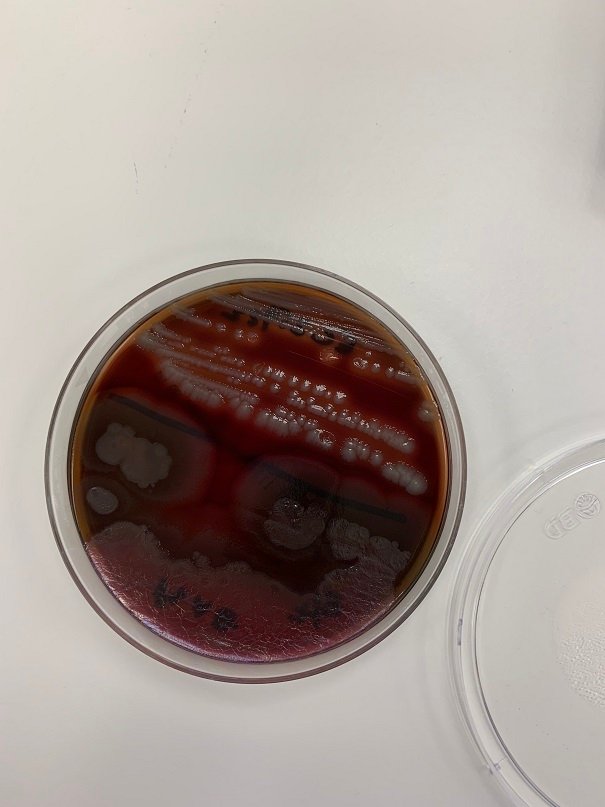Thought process...
What is wrong with this picture?

On this 5% sheep blood agar plate (SBA), you see two organisms. One is P. aeruginosa (bottom) and the other is E. coli (top). I don't remember the exact ATCC strain numbers, but these are QC organisms.
Usually, it's a bad idea to put organisms that spread throughout the plate with another on an agar. In this case, it's the P. aeruginosa. Another bacteria with similar trait is Proteus species.
Fortunately, we sub the germs you see above into new agar plates daily. So, in the grand scheme of things, this setup didn't matter. We throw these guys away at the start of a new work day.
When it comes to patient samples, I would avoid putting multiple organisms on the same plate. Spready bacteria tend to take over the plate and engulf others in their path. This is not a good idea when you are trying to set up purity plates for your susceptibility testing.
Spready organisms also tend to make isolation somewhat challenging. But, you can mitigate the spread through using selective media like MacConkey (MAC) agar or Phenylethyl alcohol agar (PEA). MAC limits the spready nature of gram negative bacteria. PEA inhibits gram negative growth and helps you isolating the gram positive ones.
What does this all mean? Oh, not much. It's a tidbit about the thoughts that goes through my mind working in a microbiology lab.
Posted with STEMGeeks
For the case of patient samples, I am sure mistakes in which multiple organisms end up in the same plate occur once in a while, don't they?
The short answer is yes. The test would then have to be repeated.
Each patient sample is inoculated into their own set of plates.
When we perform susceptibility testing, we make "purity plates" as proof that whatever colonies we picked were pure and the antibiotic resistance is not the result of different organisms mixing into the testing wells.
Mixing happens when a patient has multiple organisms and the microbiologist was not able to get a clean pick. Contamination can also happen when one tries to "economize" and put multiple organisms on the same purity plate (from the same or different patient).
Unless there's a supply constraint, I prefer to use separate plates for antibiotic testing.
But you could assess the amount of blood needed beforehand, couldn't you, so that you can do as much testing as needed (even when mistakes happen) without that the patient need to come back.
Patient sample is not limited to blood.
And for blood, only a few drops of diluted blood in broth is needed for each agar plate.
Thanks. I missed this point!
Sound exciting!
But I also didn't understand much :p
Ahh, that's too bad.
The gist of it is to not put different organisms too close together, or they might get mixed up.
Ye, I got the gist of it :D
I am pretty sure I would have similar thoughts if I worked in that field, my thoughts can be quite wild :D
Do you ensure that pure isolates are obtained and tested for susceptibility before prescribing the necessary antibiotics? I'm just curious
Clinicians may use broad spectrum ones ahead of time. But, generally yes, you want to test pure colonies only.
I tried to look closer at the photo but could not figure out what it is.. is this something related to blood ?
I mentioned this is about microbiology.
I lost count of how many plates I made xD, I think the best experience was when I studied antibiotics, bacteria grow in the whole plate less winged from the antibiotic, xD I also lost count of the times the culture goes through with the hot rod xd, beauty culture!!
I haven’t actually made my own agar. I’ve seen the process before.
Does your lab still stock those old reagents for doing those old timing consuming manual biochemical test for species identification? Our lab just cut costs on some reagents since we got a commercial test strip to hasten the process.
We got rid of them last year.
The only manual sensitivities we do now are just offline versions of MicroScan for certain organisms and the occasional mCIM test for carbapenam resistance.
Oh, and the oxacillin disk for S. pneumoniae.
Interesting
I have never seen this kind of thing before, it fascinates me to see bacteria like this
That's how they look on agars.
that's good if you throwing it what about in holidays?